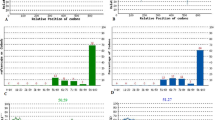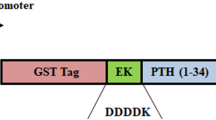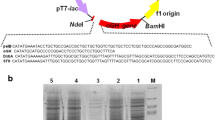Abstract
The 22 kDa of human growth hormone (hGH) is naturally produced and secreted by somatotrophic cells in the anterior part of the pituitary gland. The aim of this study was to clone, express, purify of hGH as fusion to the pelB leader in pET22b (+) plasmid and evaluate it’s biological properties. The hGH polypeptide codon was optimized and subcloned. The recombinant hGH protein was purified by affinity chromatographic system against His-tag and the presence and accuracy of the purified products were evaluated by protein electrophoresis and Western blot. The biological activity of recombinant hGH protein was measured using ELISA assay. The results of sequencing of hGH gene confirmed the presence and proper placement of hGH gene and it’s subcloning in the plasmid pET22b (+). The results of the protein electrophoresis and Western blot assays demonstrated that the expression accuracy of 22 kDa recombinant hGH. The results of Bradford spectroscopy assay showed that the recombinant hGH protein concentration was 1 g/l. The results of classical sandwich ELISA assay, in contrast to the specific antibodies, confirmed the bio-activity of the recombinant hGH protein in its targeting. Consequently, the results of this study showed that pelB leader has the ability to more accurately direct hGH to periplasmic space in Escherichia coli, and the conditions of oxidizing periplasmic space give rise to the correct folding of the protein in this space. Furthermore, the results of current study proved that using bioinformatics tools and combining them with laboratory data, could improve the recombinant hGH expression in E. coli, in addition to preserving bio-activity.





Similar content being viewed by others
References
Bagherinejad M, Sadeghi H, Abedi D, Chou C, Moazen F, Rabbani M (2016) Twin arginine translocation system in secretory expression of recombinant human growth hormone. Res Pharm Sci 11:461–469
Baradaran A, Sieo CC, Foo HL, Illias RM et al (2013) Cloning and in silico characterization of two signal peptides from Pediococcus pentosaceus and their function for the secretion of heterologous protein in Lactococcus lactis. Biotechnol Lett 35:233–238
Beckwith J (2013) The Sec-dependent pathway. Res Microbiol 164:497–504
Berks BC (2015) The twin-Arginine protein translocation pathway. Annu Rev Biochem 84:843–848
Boycheva S, Chkodrov G, Ivanov I (2003) Codon pairs in the genome of Escherichia coli. Bioinformatics 19:987–998
Chatzi KE, Sardis MF, Economou A, Karamanou S (2014) SecA-mediated targeting and translocation of secretory proteins. Biochim Biophys Acta 1843:1466–1474
Choi JH, Jeong KJ, Kim SC, Lee SY (2000) Efficient secretory production of alkaline phosphatase by high cell density culture of recombinant Escherichia coli using the Bacillus sp. endoxylanase signal sequence. Appl Microbiol Biotechnol 53:640–645
Fakruddin M, Mohammad Mazumdar R, Bin Mannan KS, Chowdhury A, Hossain MN (2013) Critical factors affecting the success of cloning, expression, and mass production of enzymes by recombinant E. coli. ISRN Biotechnol 3:1–7
Forouharmehr A, Nassiri M, Ghovvati S, Javadmanesh A (2018) Evaluation of different signal peptides for secretory production of recombinant bovine pancreatic ribonuclease A in gram negative bacterial system: an in silico study. Curr Proteomics 15:24–33
Franklin SL, Geffner ME (2011) Growth hormone: the expansion of available products and indications. Pediatr Clin North Am 58:1141–1165
Ghorpade A, Garg LC (1993) Efficient processing and export of human growth hormone by heat labile enterotoxin chain B signal sequence. FEBS Lett 330:61–65
Ghovvati S, Pezeshkian Z, Mirhoseini SZ (2018) In silico analysis of different signal peptides to discover a panel of appropriate signal peptides for secretory production of Interferon-beta 1b in Escherichia coli. Acta Biochim Pol 65:521–534
Gupta SK, Shukla P (2016) Advanced technologies for improved expression of recombinant proteins in bacteria: perspectives and applications. Crit Rev Biotechnol 36:1089–1098
Gutman GA, Hatfield GW (1989) Nonrandom utilization of codon pairs in Escherichia coli. Proc Natl Acad Sci USA 86:3699–3703
Hsu CC, Thomas ORT, Overton TW (2016) Periplasmic expression in and release of Fab fragments from Escherichia coli using stress minimization. J Chem Technol Biotechnol 91:815–822
Jeong H, Kim HJ, Lee SJ (2015) Complete genome sequence of Escherichia coli strain BL21. Genome Announc 3:e00134-15
Kaderbhai MA, Ugochukwu CC, Kelly SL, Lamb DC (2001) Export of cytochrome P450 105D1 to the periplasmic space of Escherichia coli. Appl Environ Microbiol 67:2136–2138
Kim MJ, Park HS, Seo KH, Yang HJ, Kim SK, Choi JH (2013) Complete solubilization and purification of recombinant human growth hormone produced in Escherichia coli. PLoS ONE 8:e56168
Kotzsch A, Vernet E, Hammarstrom M, Berthelsen J, Weigelt J, Graslund S, Sundstrom M (2011) A secretory system for bacterial production of high-profile protein targets. Protein Sci 20:597–609
Leader B, Baca QJ, Golan DE (2008) Protein therapeutics: a summary and pharmacological classification. Nat Rev Drug Discov 7:21–39
Levarski Z, Soltysova A, Krahulec J, Stuchlik S, Turna J (2014) High-level expression and purification of recombinant human growth hormone produced in soluble form in Escherichia coli. Protein Expr Purif 100:40–47
Lilie H, Schwarz E, Rudolph R (1998) Advances in refolding of proteins produced in E. coli. Curr Opin Biotechnol 9:497–501
Nausch H, Huckauf J, Koslowski R, Meyer U, Broer I, Mikschofsky H (2013) Recombinant production of human interleukin 6 in Escherichia coli. PLoS ONE 8:e54933
Novello D, da Fonseca RA, Pollonio MAR, Franceschini P (2009) Physicochemical evaluation and fatty acids profile of broiler chicken fed broiler diets containing barley brewer (Hordeum vulgare). Ciênc Tecnol Aliment Campinas 29:495–503
Phue JN, Lee SJ, Trinh L, Shiloach J (2008) Modified Escherichia coli B (BL21), a superior producer of plasmid DNA compared with Escherichia coli K (DH5alpha). Biotechnol Bioeng 101:831–836
Raven PH, Johnson GB, Mason LA, Losos J, Singer S (2013) Biology, 10th edn. McGraw-Hill, New York
Reh CS, Geffner ME (2010) Somatotropin in the treatment of growth hormone deficiency and Turner syndrome in pediatric patients: a review. Clin Pharmacol 2:111–122
Sambrook JF, Russell DW (2001) Molecular cloning: a laboratory manual, 3rd edn. Cold Spring Harbor Laboratory Press, Cold Spring Harbor
Saraogi I, Shan SO (2014) Co-translational protein targeting to the bacterial membrane. Biochim Biophys Acta 1843:1433–1441
Schierle CF, Berkmen M, Huber D, Kumamoto C, Boyd D, Beckwith J (2003) The DsbA signal sequence directs efficient, cotranslational export of passenger proteins to the Escherichia coli periplasm via the signal recognition particle pathway. J Bacteriol 185:5706–5713
Selvarasu S, Ow DS, Lee SY, Lee MM, Oh SK, Karimi IA, Lee DY (2009) Characterizing Escherichia coli DH5alpha growth and metabolism in a complex medium using genome-scale flux analysis. Biotechnol Bioeng 102:923–934
Sockolosky JT, Szoka FC (2013) Periplasmic production via the pET expression system of soluble, bioactive human growth hormone. Protein Expr Purif 87:129–135
Sorensen HP, Mortensen KK (2005) Advanced genetic strategies for recombinant protein expression in Escherichia coli. J Biotechnol 115:113–128
Su L, Yu L, Xu C, Wu J (2015) Extracellular expression of Thermobifida fusca cutinase with pelB signal peptide depends on more than type II secretion pathway in Escherichia coli. J Biotechnol 204:47–52
Thanassi DG, Hultgren SJ (2000) Multiple pathways allow protein secretion across the bacterial outer membrane. Curr Opin Cell Biol 12:420–430
Vahedi F, Nassiri M, Ghovvati S, Javadmanesh A (2018) Evaluation of different signal peptides using bioinformatics tools to express recombinant erythropoietin in mammalian cells. Int J Pept Res Ther. https://doi.org/10.1007/s10989-018-9746-1
Waegeman H, Soetaert W (2011) Increasing recombinant protein production in Escherichia coli through metabolic and genetic engineering. J Ind Microbiol Biotechnol 38:1891–1910
Yoon SH, Kim SK, Kim JF (2010) Secretory production of recombinant proteins in Escherichia coli. Recent Pat Biotechnol 4:23–29
Zamani M, Nezafat N, Ghasemi Y (2016) Evaluation of recombinant human growth hormone secretion in E. coli using the L-asparaginase II signal peptide. Avicenna J Med Biotechnol 8:182–187
Zhou Y, Liu P, Gan Y, Sandoval W et al (2016) Enhancing full-length antibody production by signal peptide engineering. Microb Cell Fact. https://doi.org/10.1186/s12934-016-0445-3
Funding
This study was no funded.
Author information
Authors and Affiliations
Corresponding author
Ethics declarations
Conflict of interest
The authors declare that we have no conflict of interest.
Ethical Approval
No human or animals subjects were involved in this study.
Informed Consent
This study contain no individual participant data.
Additional information
Publisher's Note
Springer Nature remains neutral with regard to jurisdictional claims in published maps and institutional affiliations.
Rights and permissions
About this article
Cite this article
Doozandeh-Juibari, A., Ghovvati, S., Vaziri, H.R. et al. Cloning, Expression, Purification and Evaluation of the Biological Properties of the Recombinant Human Growth Hormone (hGH) in Escherichia coli. Int J Pept Res Ther 26, 487–495 (2020). https://doi.org/10.1007/s10989-019-09854-y
Accepted:
Published:
Issue Date:
DOI: https://doi.org/10.1007/s10989-019-09854-y




